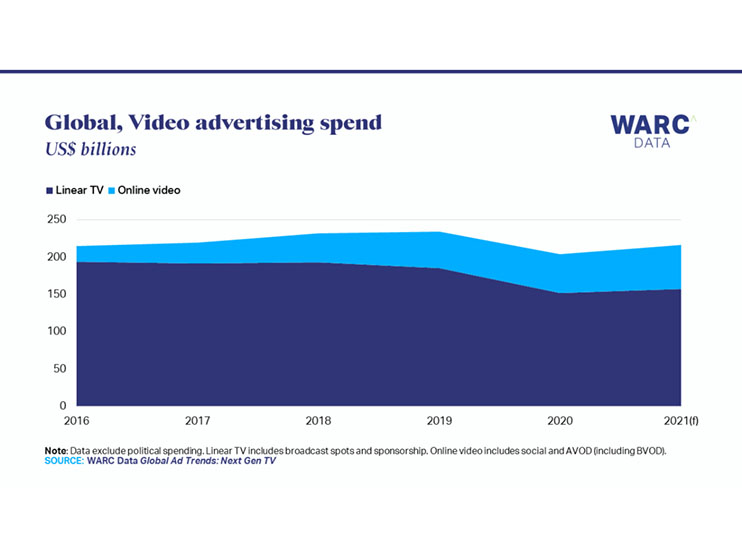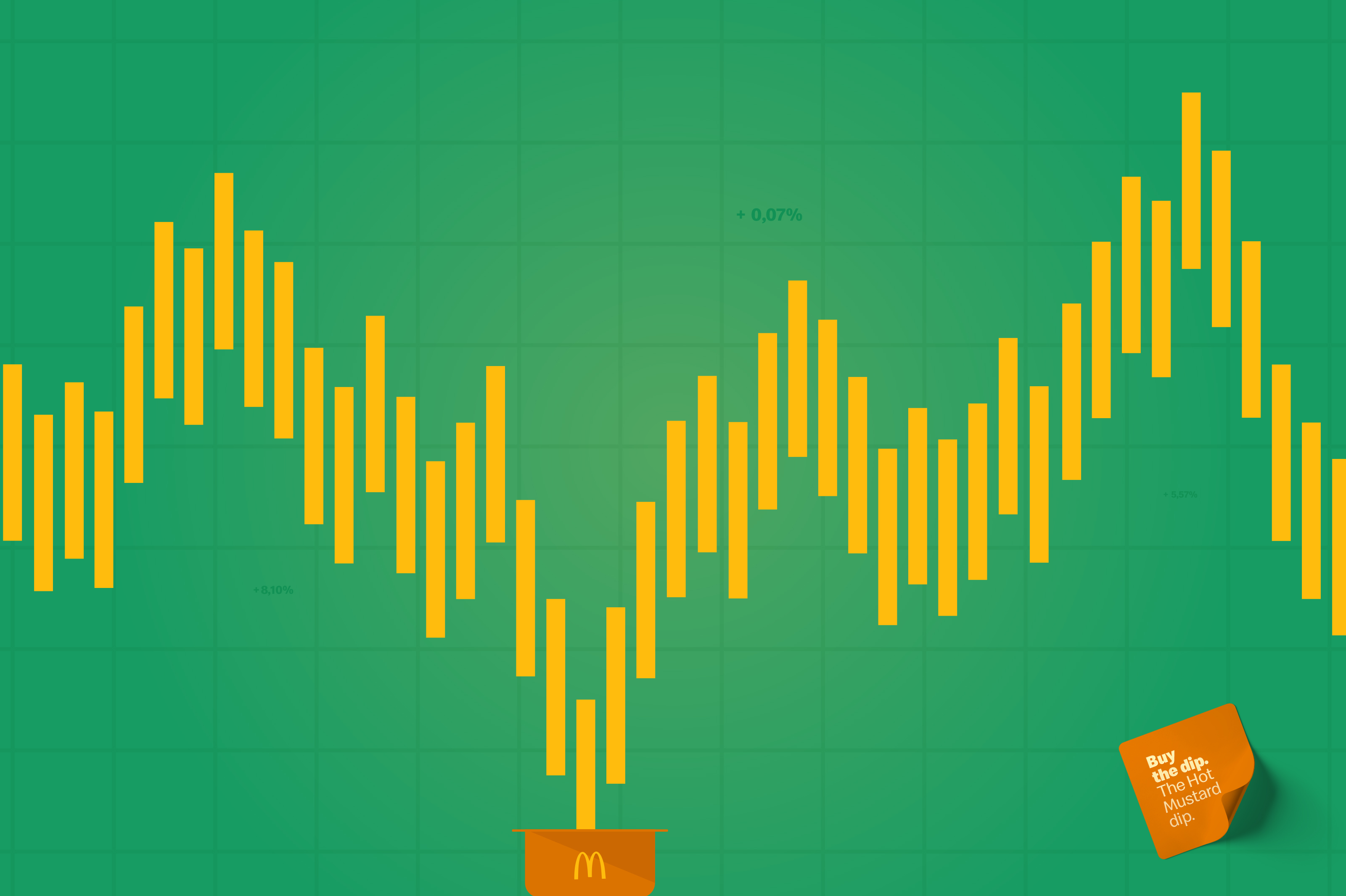News - Advertising
Broadcast TV spend fell $34bn worldwide last year as advertisers moved money into streaming platforms
February 18, 2021
.jpg) Advertisement
AdvertisementWARC Global Advertising Trends: Next Generation TV
Advertising spend on broadcast television (excluding political ads) fell by $34bn worldwide last year, as the coronavirus paralysed production and brands moved money into streaming platforms finds WARC, the international marketing intelligence service.
As the broadcast TV market ebbed last year, advertiser-funded video-on-demand (AVOD) services - including platforms such as Hulu, Peacock and YouTube - saw brand investment rise by 9.9% to a total of $26.7bn. Further, projections from Digital TV Research show that the AVOD market is set to double to a value of $54bn by 2025.
Brand investment in AVOD platforms is set to treble in value in the US over the next five years, to a total of $24.2bn, with China rising to $9.2bn, Japan to $3.2bn, and the UK to $2.8bn.
The trend mirrors the evolving viewing habits of consumers: one in four viewers is spending more time with streamed video content at the expense of linear TV in the US (26%) and UK (27%), per AudienceProject surveying, while one in three Americans now only streams video content.
2020 was a watershed moment for video streaming as linear viewing eroded
Two in five consumers worldwide now have a next gen TV - one that is able to connect to the internet either directly (i.e. smart TVs) or via an intermediary device such as a set top box, USB or games console (i.e. connected TVs, or CTVs). Roku is the preferred CTV device among consumers, accounting for almost a third (31%) of all viewing time on next gen TVs as monitored by Conviva. Amazon Fire accounts for a fifth, with games consoles taking 12%.
Streaming time across all devices rose to 28.7 minutes per play on average last year. Google's Chromecast received the longest watch time at 35.5 minutes, followed by Roku at 33.3 minutes. TV sets accounted for three-quarters (75%) of all streamed video time in Q4 2020, across CTVs (49%), smart TVs (17%) and games consoles (9%). Mobiles (10%), desktop computers (10%) and tablets (5%) accounted for the remaining time.
Mobile is still king across Asia. YouGov finds that one in three globally watches live TV on their mobile, tablet or PC, but this rises to over one in two in India (57%) and China (54%). Research by Brightcove shows that mobiles are favoured over smart TVs when streaming video content in key Asian, African and the Middle Eastern markets, while Western markets skew heavily towards smart TVs.
Commenting on the findings, James McDonald, Head of Data Content, WARC, and author of the research, says: "Consumers have never before had such a varied choice when it comes to how and where they watch video content, and the distinction between channels continues to blur - one in three Americans now regards YouTube and TV as analogous. Brands are taking note, with investment data showing a clear pivot to AVOD platforms last year.
"Like linear before it, next gen TV is demonstrating the core traits of offering mass reach for resonant creative in brand safe environments. However, unlike with its ancestor, fraud now poses a very real and present threat to advertising trade, especially among unverified vendors."
A landmark study of 16m TV ads lays the impact of coronavirus bare for the first time
Also included within this edition of Global Ad Trends is a landmark study of almost 16m ads aired on Australian TV between September 2019 and December 2020 monitored by Adgile, a next generation Total TV data and analytics industry partner. Ads were watched in real time using Adgile's patented visual recognition technology, and the data supplied to WARC for bespoke analysis.
The findings show that advertising volume fell 5% as the coronavirus outbreak took hold in Australia, with the travel & tourism and media sectors most severely hit. Conversely, the health and beauty sector saw the largest increase, with ad volume up 47.2% from pre-COVID levels.
TV ad campaigns ran for longer as production was curbed - FMCG TV campaigns are now over a week longer than was the case before the outbreak. FMCG advertisers were quick to launch new products, with 15.4% of all advertising creative within the sector centered around a new product (compared to just 2% before the outbreak).
Retailers, usually adopters of value and sales-led advertising creative, pivoted to brand-building messaging during COVID-19. A wider shift towards brand-led advertising was observed among a number of product sectors during the coronavirus outbreak, though for most this made way for product-led creative as the outbreak eased during the summer.
Commenting on the research, Paul Evans, CEO, Adgile, says: "Adgile's unique first-party brand content data, combined with WARC's insightful analysis and reporting, revealed a TV landscape in Australia that changed significantly in composition during 2020. But the impact of COVID on TV may well be felt long-beyond this period - in reframing expectations for greater flexibility of planning and buying, and the requirement for more accessible data that enables real-time measurement and effectiveness across Linear and On Demand - what we refer to as Total TV."
KEY FINDINGS:
Latest information on WARC Data across regions:
Global
• Sport turns to short-form content as new business models grow
• YouTube, Facebook failing to attract e-sports fans from Twitch
• Three-quarters of brands aren't sure about ROI from influencers
• Alphabet controls almost half of all online advertising
• Publishers are prioritising subscriptions over display and native ads
Americas
• Half of Latin American consumers tried a new store last year
• Gaming activity grew quickest among older Americans in 2020
• Half of consumers use at least two SVOD services
• One in four Mexicans buying more online for in-store pickup since COVID-19
Asia Pacific
• Asia over-indexes for live streamed video consumption
• ByteDance and Kuaishou account for nearly a quarter of mobile activity
• Only the largest Indian FMCG brands grew during COVID-19
• Top Chinese FMCG companies attracted 82m more consumers this year
Europe, Middle East and Africa
• TikTok trebles activity in Russia to become top social app
• Three-fifths of African and Middle Eastern consumers tried a new store last year
• Sky advertising revenue returns to growth for first time in two years
• Amazon adspend rose 79% in Germany in Q4 2020



.jpg)





.jpg)




